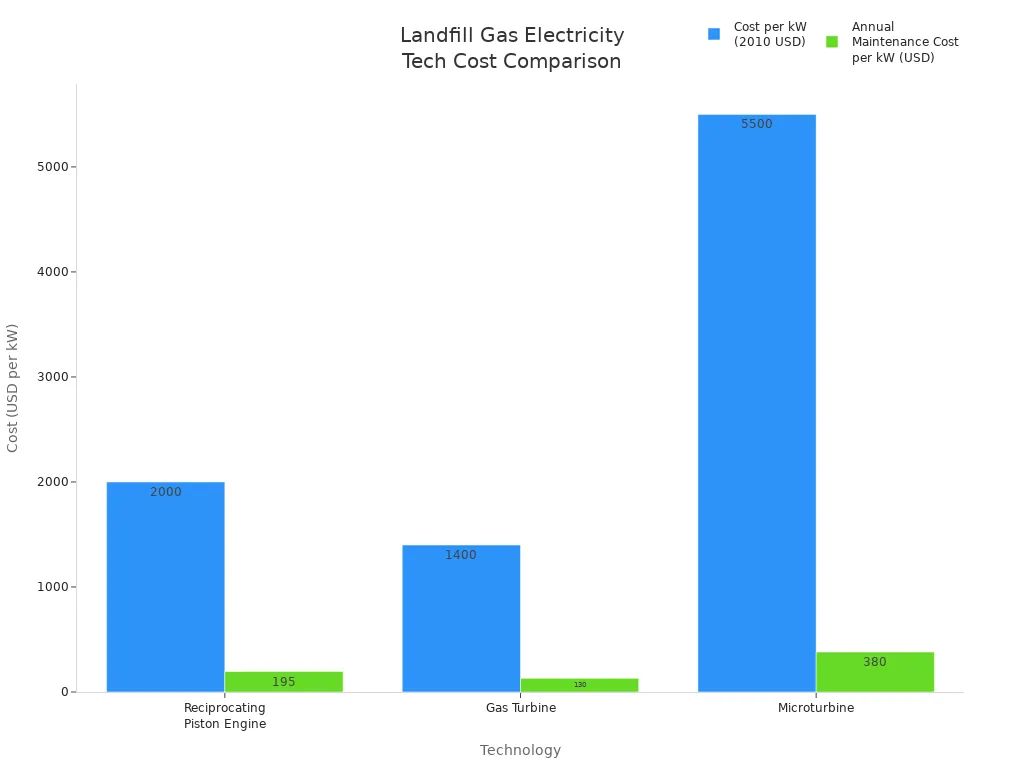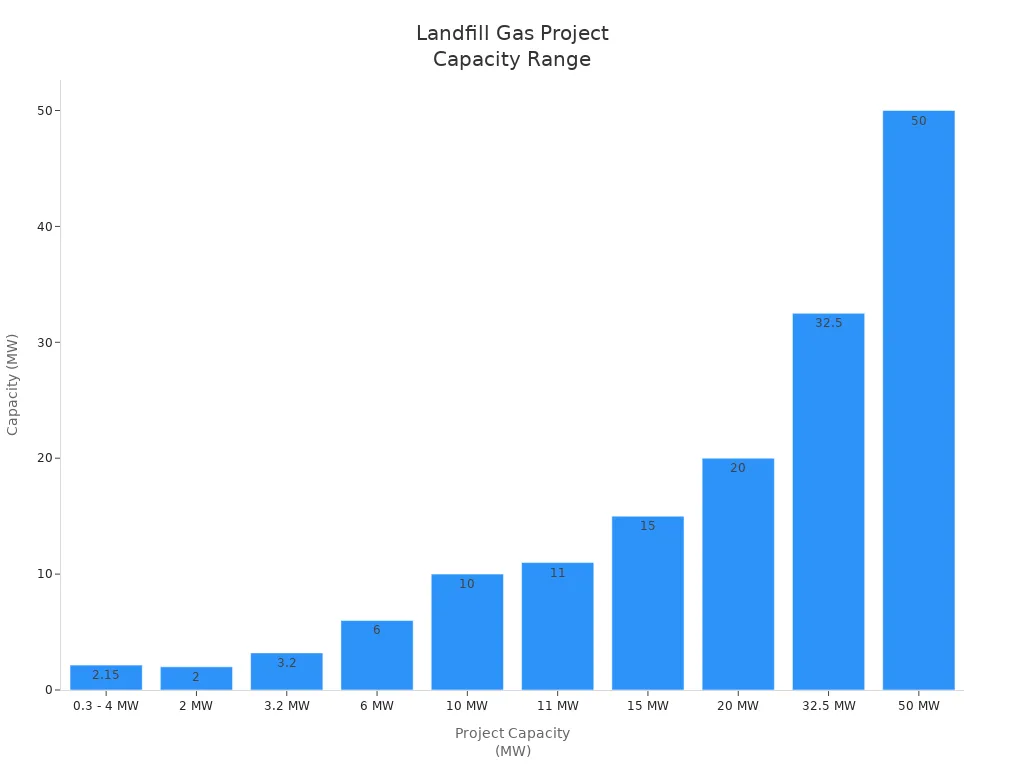Author: Site Editor Publish Time: 2025-07-29 Origin: Site





You might ask how landfill gas can power homes. When landfill waste breaks down, it makes biogas. Special systems collect the landfill gas and clean it. Then, they send it to a landfill gas generator. This process changes biogas into electricity. Every year, these projects make over 33 terawatt-hours of electricity. Using landfill gas instead of venting or flaring helps lower greenhouse gases. It also supports renewable energy. Waste to energy projects use landfill gas as a clean energy source.
Landfill gas is made when waste breaks down. Wells and pipes collect the gas. This stops leaks and bad smells.
Cleaning landfill gas takes out harmful things. This makes the gas safe and good for making energy.
Different machines like engines, turbines, and fuel cells use cleaned landfill gas. They turn it into electricity for homes and businesses.
Using landfill gas for energy lowers greenhouse gases. It also helps control smells and supports renewable energy.
People check and upgrade gas collection systems often. This helps catch more methane and keeps the environment safe.
Have you ever thought about how landfill gas gets out? Engineers put in many collection wells and pipes. These wells go deep into the trash where biogas forms. The pipes link the wells and move the gas to one spot.
Landfill gas monitoring wells are placed around the landfill edge. They help find where gas moves and if there are leaks.
Multilevel probes check for gas at different depths. They show where methane and other gases build up.
Special tools, like Flame Ionization Detectors and Infrared analyzers, measure methane. Infrared analyzers work even if there is a lot of carbon dioxide. They can check methane up to 100% by volume.
Calibration gases keep these tools working right. This helps you know how much landfill gas you collect.
Checking the system often helps find problems early. If gas escapes, you can fix it quickly. This keeps the landfill gas collection system working well.
Landfill gas collection systems use two main ways: active and passive. Active systems use pumps or blowers to pull gas from the wells. They make a vacuum that sucks the gas out. Passive systems let pressure inside the landfill push the gas through pipes.
Vertical wells and horizontal collectors cover all waste areas. They help collect as much landfill gas as possible.
Collected gas goes to control systems. These can be flares, enclosed combustion devices, or treatment units for energy recovery.
Each well is checked every month to keep the system working. You measure pressure to stop leaks and keep the right pressure at the wellheads.
Good design keeps landfill gas from leaking underground. This protects the air and keeps smells down.
Better landfill gas extraction systems can capture 10-20% more methane. Real-time monitoring and automatic tuning help get more gas and less pollution. Some landfills, like Hamm Sanitary Landfill in Kansas, got 32% more methane with better monitoring. Flares and energy recovery devices destroy at least 99% of methane, which cuts emissions and odors. Daily landfill covers and biocovers with special bacteria also help control surface emissions and smells.
Tip: Install landfill gas collection systems early and upgrade them often. This helps recover more methane and control odors. You help the environment and make biogas useful for energy.
When you collect landfill gas, it is not just biogas. The gas has many impurities mixed in. These include hydrogen sulfide, water vapor, siloxanes, carbon dioxide, ammonia, nitrogen oxides, halogens, volatile organic compounds, and particulate matter. Each impurity can cause problems for making energy and treating landfill gas.
You must take out these impurities before using the gas for energy. First, the gas is cooled down and water vapor is removed. This step also gets rid of some things that can hurt machines. Next, filters catch dust and other small particles. Membrane separation helps split methane from carbon dioxide and other gases. Pressure swing adsorption removes certain impurities and makes the gas better. Sometimes, absorption or cryogenic separation is used for even cleaner gas. To get rid of hydrogen sulfide, you might use scavengers, adsorbents, or special liquid redox systems. These steps make landfill gas safer and cleaner for making energy.
Note: Taking out impurities protects engines and turbines. It also keeps the air around the landfill cleaner.
After treating landfill gas, you get much cleaner biogas. This step is called biogas upgrading. The gas is dried and its mix is changed. Taking out moisture helps stop engine damage. If siloxanes stay in the gas, they can make hard deposits inside engines. These deposits can break engines and make them less reliable. Removing siloxanes helps your equipment last longer.
You also make the gas stronger by changing carbon dioxide levels. This means you get more energy from each cubic foot of landfill gas. Cleaner gas helps generators work better and break down less. You use many biogas upgrading steps to remove different impurities. This careful process helps make energy from landfill gas and turns it into renewable natural gas.
Here’s a quick look at the main steps in landfill gas processing:
Step | Purpose |
|---|---|
Gas cooling/condensation | Remove water vapor and condensable compounds |
Filtration | Remove particulate matter |
Membrane separation | Separate methane from CO2 and other gases |
Pressure swing adsorption | Selectively adsorb impurities |
Absorption/cryogenic steps | Further purify and upgrade biogas |
Each step helps make landfill gas better. This makes landfill gas a good choice for renewable natural gas and energy. Using the right landfill gas processing helps make cleaner energy and better landfill management.
To make electricity from landfill gas, you need a landfill gas generator. This machine uses cleaned landfill gas to make power. First, the gas goes into the generator. Inside, the gas burns or reacts and gives off energy. The generator takes this energy and makes electricity. After that, the electricity can go to homes, schools, or businesses.
Most landfill gas generators use three main types of technology: internal combustion engines, turbines, or fuel cells. Each one works best for different landfill sizes and gas quality. You can see how they compare in the table below:
Technology | Operation Principle | Efficiency Range | Typical Scale (kW to MW) | Notes |
|---|---|---|---|---|
Reciprocating Piston Engine | Burns landfill gas in an engine to drive a generator | 25% to 35% | 150 kW to 3 MW | Most common; cost-effective; easy to scale up or down |
Gas Turbine | Uses compressed landfill gas to spin a turbine | 20% to 28% | 1 MW to 10 MW | Good for large landfills; lower emissions; needs high gas pressure |
Microturbine | Small turbine for lower gas flow and methane | N/A | 30 kW, 70 kW, 250 kW | Best for small landfills; needs very clean gas |

Most landfill gas projects use internal combustion engines. These engines are like car engines but use landfill gas. The gas mixes with air and burns inside the engine. This burning moves pistons up and down. The pistons turn a crankshaft. The crankshaft spins the generator to make electricity.
Internal combustion engines are popular because they can handle changes in gas flow. You can add or remove engines if the landfill makes more or less gas. These engines work well for small and medium landfills. They also cost less to buy and fix than other types. Their efficiency is between 25% and 35%. So, if you start with 100 units of landfill gas energy, you get 25 to 35 units of electricity.
Tip: If your landfill always has gas, you can run these engines almost all year. This helps you make electricity without stopping.
These engines need regular care. You should check for deposits inside the engine. Dirty landfill gas can cause these deposits. Cleaning the gas first helps the engine last longer and work better.
Gas turbines use landfill gas in a different way. The gas gets squeezed and mixed with air. When it burns, hot gases spin blades inside the turbine. This spinning makes the generator turn and produce electricity. Turbines are best for big landfills with lots of gas. They need high gas pressure and very clean gas. Turbines cost less to fix and make less nitrogen oxides than engines. Their efficiency is between 20% and 28% when running at full power.
Microturbines are smaller turbines. You can use them at landfills with less gas. They need even cleaner gas and cost more for each kilowatt. Still, they help small towns make electricity from waste.
Fuel cells are the newest way to use landfill gas. They do not burn the gas. Instead, they use a chemical reaction to make electricity from landfill gas. This process makes very little pollution. Fuel cells can be more efficient than engines or turbines. Sometimes, they reach up to 60% efficiency in special setups. They also make less pollution, which is better for the environment. But fuel cells need very clean landfill gas. They also cost more to buy and run, so people use them less often.
Note: Fuel cells can work for a long time with little care, but you must remove almost all impurities from the landfill gas first.
Each landfill gas generator technology has good and bad points. Internal combustion engines are flexible and cost less. Turbines are good for big landfills with steady gas flow. Fuel cells make the cleanest electricity but need the cleanest gas and cost more.
Landfill gas generator projects can make different amounts of electricity. Most sites make between 0.3 and 4 megawatts. Some big landfills, like Puente Hills, can make up to 50 megawatts. This much electricity can power thousands of homes or even whole towns.

Using a landfill gas generator helps lower greenhouse gases. It also supports renewable energy and gives steady electricity. These projects create jobs and help local economies. With new technology, landfill gas generators will work even better and make cleaner energy in the future.
You learned how landfill gas goes from wells to generators. This process changes landfill waste into electricity. First, workers extract the gas. Then, they clean it. After that, the gas is turned into power. Using waste to energy helps make landfills smaller. It also lowers greenhouse gases. Landfill gas projects catch methane for many years. This makes landfills safer and cleaner. When more landfills use new waste to energy systems, you help the planet. Landfill gas can power homes and protect the earth.
You help the environment when you use landfill gas for energy. This process captures methane, a strong greenhouse gas. It stops methane from escaping into the air. You also reduce odors and make landfills safer for everyone.
You cannot use landfill gas directly at home. Power plants or generators turn landfill gas into electricity. This electricity goes into the power grid. You use it when you turn on lights or charge your phone.
If you do not collect landfill gas, methane and other gases escape into the air. This can cause bad smells and increase greenhouse gases. It may also create safety risks near the landfill.
A landfill can make gas for 10 to 50 years after closing. The amount of gas drops over time. You can keep making electricity as long as enough gas comes from the landfill.
FerroAlloyNet 26th International Chrome & Nickel & Stainless Steel & New Energy Forum
GPOWER 2024 Concludes Successfully | Liyu Unveils New Products, Captivating Attention
How Liyu Containerized Generators Help Customers Achieve Cost Reduction and Efficiency Improvement
6th National Ferroalloy Large Furnace New Technology Training Exchange Conference
Empowering Skills, Energizing Growth — Liyu Overseas Partners Training Kicks Off
Inaugural 2025 Ferroalloy Commodity Week & 15th China Ferroalloy Industry Conference